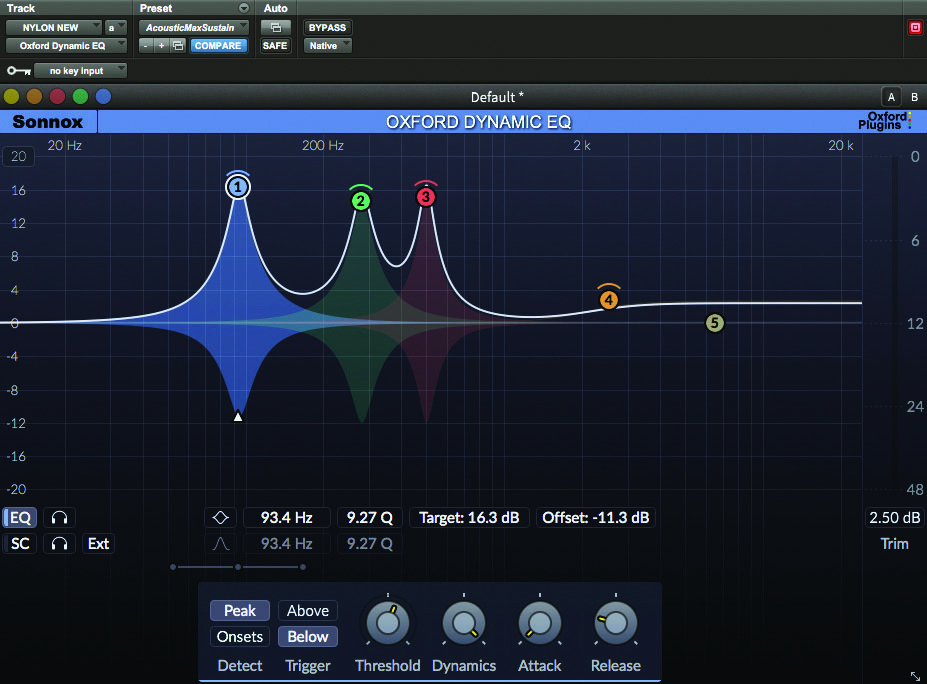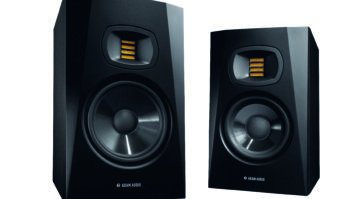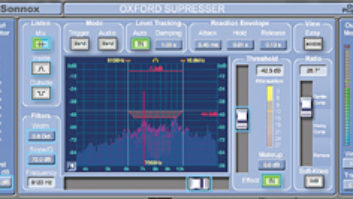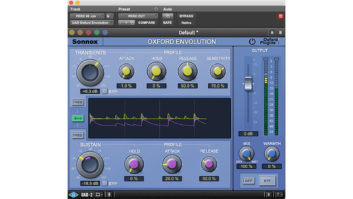
Both multiband processors and dynamic EQs work by splitting the input signal into multiple frequency bands for individual processing. A multiband compressor/limiter/expander applies gain reduction to individual frequency bands and then recombines them for a full-range output with concomitant phase shift at the crossover points. Along with less precision than a parametric EQ, the effective use of a high Q filter in one band (for fixing a problem) and a low Q filter (for enhancement) in an adjacent band is problematic for multiband compressor/expanders.
The Sonnox Oxford Dynamic Equalizer differs because it directly reduces or increases the gain of any its five parametric equalizer bands. In addition to a dynamic EQ, a static EQ is also available for each band. The plug-in uses proportional Q filters based on the Oxford EQ’s Type 3 proportional Q plug-in. The Q range is adjustable from 0.5 to 16 per dynamic band; you may do “surgery” on one problem frequency with a dynamic narrow Q and then gently treat an adjacent frequency band with a static EQ, another dynamic EQ or both at the same time.
CONTROLS OVERVIEW
I tested version 1.1 in Mac OS 10.11.5 and Pro Tools HDX 12.8.2. Currently, it’s Native AAX, VST, RTAS, UAD, available for PCs, and coming soon will be an HDX DSP version, plus a streamlined three-band variant.
The large GUI opens with an always-on 20 to 20k Hz graphical spectrum analyzer. There are five EQ bands, each represented with different colored nodes (handles) placed across a 0dB centerline. A vertical scaling button sets the maximum dynamic EQ range possible as shown on the spectrum analyzer. It’s adjustable between ±4, 6, 12 and 20 dB, with the 12dB range as default. All five bands are identical, range from 20 to 20k Hz, fully overlap and have three EQ filter types available: low or high shelving, and bell peaking curves.
There are two gain handles for each of the five bands. Offset Gain is the static gain (+/-) of the equalizer band and has an arrow that always points toward the Target Gain handle. Target Gain is the instantaneous gain the EQ band will attempt to reach dynamically. Whether set to boost or cut, EQ gain for each band is constrained within these two handles.
Target and Offset gain, frequency and Q values are indicated in a separate readout table just above the Dynamic Control window. Values can be directly typed in or mouse-adjusted, or the user can freely click-drag the handles around the GUI. A matching color “EQ” button on the left side of the GUI bypasses any band and/or its sidechain section. You can also double-click an EQ handle and bypass both together.
Stereo instances of the EQ have five choices to direct the dynamic EQ process specifically to the: L/R channels (stereo), or the Left, Right, Mid or Side channels individually. The same goes for the sidechain filter.
Underneath the EQ bypass button is the Side-Chain (SC) in/out button. The same 20-20k Hz range, filter shapes and Qs of the dynamic filter are available. A dragging handle appears to adjust frequency and Q of a fixed-frequency bandpass filter for further focus on a particular frequency range. Last, there is an EXT button to allow an external signal be used in the sidechain.
DYNAMIC CONTROLS
When any dynamic EQ band node is selected, that band’s set of individual Dynamic Controls appears at the bottom of the GUI. Like setting a compressor, these controls set the separate gain-changing characteristics for each of the five bands.
The Detect section has Peak and Onsets detection modes. Peak sets the detector to react to peak signal level of the selected band. Onsets mode is used to react to transients—a band’s sudden change in level—such as for de-essing.
I liked the Threshold control design; it has a VU level meter built into a collar surrounding its control knob. The Threshold’s knob setting is instantly viewed relative to the frequency band’s incoming signal level.
Setting the threshold is critical, and I found the knob’s sweet spot to be either just above or below the max level indicated on the level meter. Selecting the Trigger section’s Above and Below modes determine whether you want the band’s gain to change when the signal goes above the threshold or below the threshold setting.
Above mode is for downward compression (Target Gain setting is less than Offset) and upward expansion (Target is greater than Offset). Below mode is for upward compression (Target is greater than Offset) and downward expansion-gating (when Target Gain is set less than Offset).
Dynamic Controls finishes with the Dynamics knob—a kind of compression ratio or depth control ranging from 0% to 100%. (Generally, I start with this control at 100%). The Attack knob (0.10ms to 250ms) sets how fast/slow the band reaches Target Gain, and Release (5ms to 1sec) determines how slowly the band recovers to the Offset Gain setting. The GUI shades in the area between Target and Offset values with the dynamic changes shown as a moving line between those extremes.
TRY THIS
With double-track guitars spread wide left and right in my mix, I used Sonnox Dynamic EQ on the left-side track (as described previously) and Sonnox’s 3-band EQ on the right-side track. This produces an even wider stereo effect because of the different and opposing EQ changes happening.
GETTING DYNAMIC
I compared this Dynamic EQ with Sonnox Oxford’s 3-Band EQ on a pair of (double-tracked) distorted and dark-sounding electric guitars. I could dynamically boost more in the 2kHz region to bring out just the pick attack without overly brightening and thinning out the body of the sound. With the Detector set on Peak, the Threshold control becomes a critical adjustment. Besides brightening only on the louder peak energies of the picking, the guitars gain more dynamic “life”!
Onsets mode reacts to only sudden increases in signal level, and I found this mode excellent for de-essing without trashing the rest of the vocal sound, as is the case with a lot of de-essers, both hardware and software. I could use a single instance of Sonnox Oxford Dynamic EQ as a conventional vocal equalizer with two static (Offset) curves (0% Dynamics) and then, using two dynamic sections, find the frequency center of two different “s” frequencies. I then used very narrow Qs (16) to compress only when they were above Threshold. I would follow this process with a hardware compressor for leveling the vocal out for mix, and the result was less sibilant energy brought up by the compressor.
I loved upward expansion for a nylon guitar solo. I used the full 20dB dynamic range scaling and picked out three frequency nodes of certain notes the player allowed to ring out. I set up the plug-in to upward-expand on those notes using a Q of 10. I was expanding from -14dB Offset gain to over +14dB Target gain! For this to work well, the recording has to be very clean and without any leakage.
Setting Threshold is a little tricky here, but I was able to make the guitar sound like it was feeding back on just those three notes when the player let them ring. It was as if it was an electric guitar solo in front of a loud amp. Just an amazing effect with a single plug-in!
AWESOME TOOL
I’ve started using the Sonnox Oxford Dynamic EQ on more individual instrument and vocal tracks in my pop music mixing. It gives the opportunity to sculpt individual tracks dynamically relative to the exact part and placement within the production. The Sonnox Oxford Dynamic EQ begins as an excellent parametric equalizer and steps up with a powerful dynamic engine. Highly recommended.
PRODUCT SUMMARY
COMPANY: Sonnox LTD
WEB: www.sonnox.com
PRODUCT: Sonnox Oxford Dynamic EQ
PRICE: £200 (about $268)
PROS: A wondrous-sounding EQ; problem solver; great for effects.
CONS: Learning curve, understand the controls to get the most out of it.
Barry Rudolph is an LA-based recording engineer and educator. You can visit him at www.barryrudolph.com.





